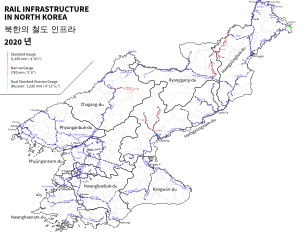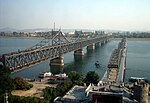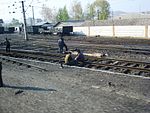Rail transport in North Korea

Rail transport in North Korea is provided by Korean State Railway (조선 민주주의 인민 공화국 철도성, Chosŏn Minjujuŭi Inmin Konghwaguk Ch'ŏldosŏng) which is the only rail operator in North Korea. It has a network of over 6,000 km of track, of which the vast majority is standard gauge; there is, however, nearly 400 km of narrow gauge lines (762 mm) in various locations around the country.[1]
Routes
[edit]In many cases, the name of the line is a portmanteau of the original termini. However, because of the division of Korea, some lines now terminate short of their original destinations. The following lists the main standard-gauge trunk lines:
- Hambuk Line: Ch'ŏngjin Ch'ŏngnyŏn - Rajin, 331.1 km, 1,435 mm (4 ft 8+1⁄2 in)
- Kangwŏn Line: Kowŏn - P'yŏnggang, 145.8 km, 1,435 mm
- Manp'o Line: Sunch'ŏn - Manp'o, 299.9 km, 1,435 mm
- Paektusan Ch'ŏngnyŏn Line: Kilchu Ch'ŏngnyŏn - Hyesan Ch'ŏngnyŏn, 141.7 km, 1,435 mm
- P'yŏngbu Line: P'yŏngyang - Kaesŏng (-> Dorasan, ROK), 187.3 km, 1,435 mm
- P'yŏngdŏk Line: P'yŏngyang - Kusang Ch'ŏngnyŏn, 192.3 km, 1,435 mm
- P'yŏngnam Line: P'yŏngyang - Namp'o, 55.2 km, 1,435 mm
- P'yŏngra Line: P'yŏngyang - Rajin (and on to Khasan, Russia), 819.0 km, 1,435 mm
- P'yŏngŭi Line: P'yŏngyang - Sinŭiju (and on to Dandong, China), 225.1 km, 1,435 mm
Stations
[edit]Pyongyang Metro
[edit]The Pyongyang Metro operates the only known underground mass transit in North Korea. Metro services are also supplemented with above-ground tram services in both Pyongyang and a number of secondary cities.
International services
[edit]
China
[edit]The primary rail gateway to North Korea is via the Sino–Korean Friendship Bridge from Dandong, China to Sinuiju, North Korea. Passenger trains are taken as far as Dandong by the China Railway at which point the domestic Chinese carriages are uncoupled and North Korean carriages and locomotive are attached. There are several other active border crossings with China, including at Manp'o and at Namyang.
Russia
[edit]Rajin has a rail link to the Russian Railways system over the Friendship Bridge across the Tumen River in the North Korea–Russia border. There is transborder passenger service from Pyongyang to Moscow, with a Korean rail car taken across the border (with bogies changed to the Russian gauge), and eventually attached to a Vladivostok-Moscow train.[2][3]
Since 2013 the line over the Tumen River to Rajin is rebuilt with dual gauge track, so that standard gauge and Russian broad gauge trains from the Russian Khasan can access the port of Rajin. Railway and port are operated in a joint venture with the Russian RasonKonTrans.[4]
South Korea
[edit]In 2000, a freight service was inaugurated, between South Korea and the industrial park at Kaesong; however, usage has been very low and most trains carry no freight.[5]
Rolling stock
[edit]Presidential trains
[edit]Future plans
[edit]A Trans-Korean Main Line is planned, spanning North Korea and allowing South Korean rail freight access to Russian Railways.[6]
Gallery
[edit]-
Locomotive in North Korea
-
Crossing into North Korea on the Sino–Korean Friendship Bridge
-
Sino–Korean Friendship Bridge
-
Railway electrification
-
Maintenance works
-
Sinanju station building
-
Pyongyang station at night
History
[edit]Much of the rail network in Korea was built during the period of Japanese rule, which ended in 1945. There were 2,792 km (1,735 mi) of railway in 1925.[7] Much was damaged or destroyed during the Korean War.
See also
[edit]References
[edit]- ^ Hayato, Kokubu, 将軍様の鉄道 (Shōgun-sama no Tetsudō), ISBN 978-4-10-303731-6
- ^ The forbidden railway: Vienna - Pyongyang 윈 - 모스크바 - 두만강 - 평양. Our train trip via Russia to North Korea - using an officially closed for foreigners route inside the "Hermit Kingdom"
- ^ Boarding the direct train to Pyongyang, 2008-09-15
- ^ North Korean Rail Link completed Archived 2020-10-22 at the Wayback Machine, Railway Gazette International, viewed on 1 October 2013
- ^ Spencer, Richard (2010-10-30). "Korean detente railway becomes ghost train - Telegraph". The Daily Telegraph. London. Retrieved 2010-10-30.
- ^ "Trans-Korean Main Line – Investment in the Future – Russian Transport Daily Report". 2010-10-29. Archived from the original on 2011-02-27. Retrieved 2010-10-30.
- ^ Everyman's Encyclopaedia, 1931, volume 8, pp 217-218








